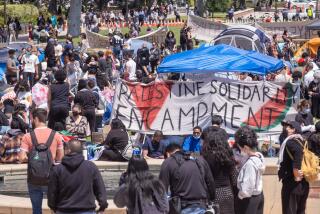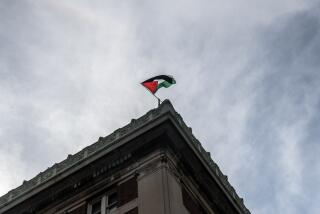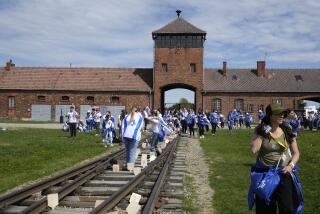Weighing the aftermath of atrocity
In “After Such Knowledge” Eva Hoffman attempts to define the place of the Holocaust in the present moment’s consciousness while emphasizing the experience, role and responsibility of the survivors’ children, of whom she is a most thoughtful and probing representative. Though fairly compact, it is an ambitious book that seeks to bring together (in the writer’s terms) both the psychocultural and sociopolitical aspects of “the impact of the Holocaust and its ‘reception’ in the postwar world.” At the same time, Hoffman, a gifted memoirist -- “Lost in Translation” told the story of her family’s emigration from postwar Poland to Canada -- particularizes these broader reflections by offering relevant pieces of her own biography and that of her parents.
In her introduction, Hoffman describes the book as “an extended essay ... informed by long-standing personal and intellectual engagement” with the aftereffects of the Holocaust. Although the author’s curiosity about and commitment to her subject are undoubted, the resulting work is highly uneven. On the positive side are deeply felt and effectively conveyed experiences and insightful analysis. On the less positive are occasional doughy writing; unsupported generalizations that cry out for facts, examples and citations; and a lack of rigorous editorial shaping.
Hoffman is, unsurprisingly, strongest when recounting her personal experience as part of the so-called second generation. Her parents grew up in Zalosce, a shtetl some 200 miles east of Lvov that before the war had belonged to the Polish part of Ukraine. During the war, the Hoffmans hid in a bunker in the forest and were later concealed, with the help of local Ukrainian and Polish friends, in the attic of a cottage that belonged to Ukrainian peasants. After the war, they moved to Krakow, where Hoffman was born in 1945 and lived until she was 13, when the family immigrated to Canada.
Other than her parents, all the adults who had once formed Hoffman’s family group died during the war. War, Hoffman writes, “penetrated the very fabric of my childhood.” As she grew up, the war caused her to see herself as “a receptacle of a historical legacy.” What this means is that she, like other children of survivors, “had to ... struggle with some of the defining issues that follow from atrocity: the internal impact of gratuitous violence and the transmission of traumatic experience across generations; the emotional intricacies of dealing with victims of persecution and the moral quandaries implicit in dialogues with perpetrators; the difficulties of witnessing the pain of others and of thinking about tragic pasts; and the relationship of private memory to a broader understanding of history.”
This, in summary, is the ground Hoffman covers in her book. It also embodies the book’s great challenge: how to make such sweeping statements specific, vivid and sharp.
Hoffman does this best when she takes us into the homes and hearts of survivor families like her own, places where the notable muteness of the survivors was “largely a misconception”: Her parents spoke to her in “the language of the body,” she explains -- in nightmares, sighs, illness, tears and aches. There was the language of the survivors’ behavior too: the tribal closeness and patriarchal authoritarianism (both, however, diminished somewhat with emigration, whose role she feels has been underestimated in the biographies of survivors and their children); the mothers’ overprotectiveness; and the fact that survivors could often communicate more directly with their grandchildren than with their children.
Her parents conveyed a great deal through absence. Because they spoke so little about their prewar lives and had no surviving family and no objects other than a single photograph, “the cut from the past was complete.” Interestingly, however, Hoffman comes to understand that her parents’ worldview was, in the end, critically different from hers because they had had lives before the Holocaust, whereas she (like all children of survivors) had not.
The reader feels Hoffman circling around and around this dilemma of growing up so close to profound suffering but knowing it only secondhand. She acknowledges that survivors are often difficult and sad people, yet like her parents they could also often be “cheerful, amused, and enterprising.” She longs to rescue her parents from grief and mourning, and she identifies in herself a phenomenon she calls “significance envy”: “The sojourn in hell and the drama of survival conferred on these parents a kind of existential grandeur that no ordinary experience could match.” Envy, and value too: Her parents’ sadness put her in touch, she feels, with basic human experience that families unlike hers seldom know.
Hoffman is on less convincing ground when she widens her lens to take in some of the political and sociological factors that determined her family’s fate. On the experience of the Jews in Poland she is especially suspect. She contends that it has “been repeatedly shown to be untrue” that the Germans established most of the concentration camps on Polish soil because they “counted on the collusion of the Poles in their annihilationist project.” She also asserts that Poland was the country that mounted the largest resistance against the Nazi occupation. But where is her evidence? Where are her statistics? Though Hoffman is aware of the Polish-perpetrated massacres at Radzilow and Jedwabne -- she even attends, and in a late chapter carefully describes, the Jedwabne memorial held in July 2001 -- she seems insufficiently perturbed by a fact like this one, reported by Jan Gross in “Neighbors,” his 2001 book on the Jedwabne pogroms: “In the Jewish Historical Institute in Warsaw alone one can find over seven thousand depositions collected from the survivors of the Holocaust immediately after the war, which provide voluminous evidence of collusion by the Poles in the destruction of their Jewish neighbors.”
And, except in one brief aside, she never addresses the role of the Catholic Church in fueling Polish anti-Semitism -- or the Holocaust generally, for that matter.
Is this the Pole in Hoffman, somewhat willfully blinded by her place of origin? Perhaps. Is it the forbearance of a woman sensitive to the amount of time that has passed since the war, who wishes to emphasize understanding and rapport over bitterness and rancor? Quite possibly. But such corrections of accepted historical truth need to be built on the most solid of argumentative grounds, and hers are not.
Similarly perplexing are the intermittent foggy sentences that run through the book -- for example, “Suffering is suffering, no matter how howlingly extreme. It is something you live with; take on; suffer.” Then there is the frequency of what one might call overly pretty phrases, such as the one Hoffman applies to her mother’s memories of her time in the forest bunker -- she calls them “dark amulets” -- or her reference to “the sacredness of suffering, its untouchable, dark delicacy.” Delicacy? This aestheticizing of pain is problematic at best.
But Hoffman is nothing if not a persistently paradoxical writer. Interspersed with these disappointments are a number of valuable inquiries into the legacy of the Holocaust. She is, for instance, unafraid to look at the subject now emerging in studies of the war: what it felt like, in Germany particularly, to be on the receiving end of the vindictiveness of Allied retributions. Acknowledging Peter Novick, whose “The Holocaust in American Life” drew attention to the promotion of the Holocaust as central to American Jewish identity, she wrestles with the way it should be thought about now, from our receding distance. She worries, quite reasonably, about “the pressures on survivors to become professional witnesses,” an assignment that “may result in an odd distancing from their own experience.” In America’s current preoccupation with the causes and cures of trauma, she is concerned about the dangers of making the Holocaust an empty symbol by bringing its “formidable weight ... to bear on commonplace problems of everyday life.” Still ahead, she feels, is the task of further examining both the perpetrator mentality and the charged issue of Jewish passivity during the Holocaust. She is also justly unsettled by the reemergence after Sept. 11 of global anti-Semitism, whose combination of “religious fanaticism and polite prejudice ... make expressions of anti-Jewishness once again possible.”
Toward the end of the book, Hoffman and her sister make a poignant journey to the village of Zalosce, where everything once was and then was lost. She meets an old woman who knew the family: “But she’s Hava to the life!” this woman says of Hoffman’s sister, comparing her to their paternal grandmother, a woman neither of the Hoffman girls ever saw, in life or in a photograph. There is a stabbing moment, worthy of a novel, when Hoffman visits the place where her mother’s sister died (she and other villagers had to dig their own mass grave before they were shot), and there is her equally haunting visit to the pasture that was once the Jewish cemetery; where her father buried his slain brothers, today cows obliviously graze.
She sees the site of her mother’s house and her father’s house and, finally, the place in the forest where they hid: “I stare downwards in a state of incredulity. So this was where It started, this cavity in the ground from which my life and the world had emerged. A kind of womb after all, as well as the heart of darkness.” These are clear, stirring sentences, and they redeem Hoffman’s intermittently opaque book. *
More to Read
Sign up for our Book Club newsletter
Get the latest news, events and more from the Los Angeles Times Book Club, and help us get L.A. reading and talking.
You may occasionally receive promotional content from the Los Angeles Times.









